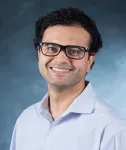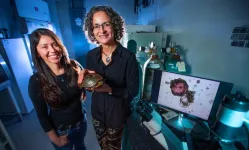(Press-News.org) Chestnut Hill, Mass. (03/05/2024) – Boston College researchers used a mild charge of electricity to precisely modify proteins, a new tool that can be used to develop novel biotherapeutics and protein-based research tools, the team reported recently in the journal Nature Chemistry.
The team, led by BC professors of chemistry Abhishek Chatterjee and Eranthie Weerapana, developed and optimized a novel electrochemical protein labeling reaction called "eCLIC", that enables precise modification of site-specifically incorporated 5-hydroxytryptophan (5HTP) residues on many different proteins including full-length therapeutic antibodies.
“We used this strategy to generate many site-specific protein conjugates, including an antibody-cytotoxic drug conjugate that selectively enters and kills cancer cells, but not non-cancer cells,” said Chatterjee. “A key advantage of eCLIC is the reagents needed for this method are really inexpensive, costing less than $10 a gram.”
The team’s success marked the first time electrocatalysis has been used to achieve protein modification in a site-specific manner, they reported December 11 in their article “Electrochemical labeling of hydroxyindoles with chemoselectivity for site-specific protein bioconjugation.”
Proteins are large molecules, typically composed of hundreds of amino acid monomers, Chatterjee noted. The ability to selectively modify proteins at predefined sites is important for many applications. For example, by covalently attaching toxic drugs to antibodies it has been possible to selectively deliver them to cancer cells, which resulted in both improved therapeutic efficacy and reduced off-target toxicity.
Many research applications also require the attachment of biophysical probes onto various proteins. The ability to define the site of modification on proteins is critical to ensure that important protein functions are not harmed, Chatterjee said.
“The challenge arises from the fact that all proteins are made from 20 amino acids in various combinations,” he said. “Identifying a modifiable functionality at the desired site, not repeated elsewhere, is typically challenging, which makes it difficult to achieve site-specificity in protein modification.”
To overcome these challenges, the team sought to develop a method to incorporate a non-natural amino acid at any chosen site(s) of a protein. The team accomplished this by reengineering the translation system of cells to accommodate the new amino acid 5HTP.
In addition, the researchers wanted to design chemical reactions that could be used to selectively modify this nonnatural amino acid in the presence of all of the natural amino acids, Chatterjee said.
“If we could do this, we could provide a general method to generate proteins with a built-in 'attachment-handle' at a predefined site. In particular, we were interested in developing a reaction that would use electricity to catalyze the protein modification reaction, instead of chemical catalysis, since the former is inexpensive, environmentally friendly, and gentle on delicate proteins.”
Chatterjee said the team was able to overcome an unusual challenge when they first tried to model the reaction. Typically, researchers start with small molecules, in this case 5HTP and aniline, then move on to large proteins.
But first attempts at the reaction between 5HTP and anilines at the small-molecule level was messy, as the 5HTP molecules reacted preferentially with each other. But when 5HTP was incorporated into a large protein, it was no longer able to react with another protein-bound 5HTP, and cleanly reacted with an aniline instead, the team reported.
“If we had stuck with the traditional progression – from small to large – we'd have never pursued eCLIC, thinking 'it's too messy’,” Chatterjee said. “Instead, we did our reaction development non-traditionally, directly on a protein, which helped us realize how clean and selective it was in this setting.”
To further advance the eCLIC strategy for large-scale modification of important protein targets, this technology has been licensed toBrickBio, Inc., which Chatterjee co-founded. Future research will focus on developing next-generation, site-specifically modified protein-based biotherapeutics and research reagents.
In addition to Chatterjee and Weerapana, co-authors of the paper were post-doctoral researchers Soumya Jyoti, Atanu Mondal, and Singha Roy; and graduate students Conor Loynd, Vincent J. Ovalle, Sarah E. Canarelli, Delilah Jewel, and Elise D. Ficaretta.
END
Boston College researchers use electrocatalysis for site-specific protein modification
Novel electrochemical protein labeling reaction enables precise modification of site-specifically incorporated 5-hydroxytryptophan (5HTP) residues on many different proteins, including full-length therapeutic antibodies
2024-03-05
ELSE PRESS RELEASES FROM THIS DATE:
Infotainment is coming for your news, warns Concordia Ph.D. student Robert Marinov
2024-03-05
There are plenty of reasons to worry about the quality of contemporary Canadian journalism, beyond shrinking newsrooms and attention spans.
Once considered a vital pillar of a healthy democracy, the country’s biggest newspapers have been embracing the type of content critics refer to as “infotainment,” which uses entertainment-style methods to communicate politically relevant information.
In a new paper published in the Canadian Journal of Political Science, PhD candidate Robert Marinov examines, measures and evaluates the scope and nature ...
Lab-grown liver organoid to speed up turtle research, making useful traits easier to harness
2024-03-05
AMES, Iowa – At a Biotechnology Council event a few years ago, Nicole Valenzuela’s ears perked up when she heard what a group of researchers in Iowa State University’s College of Veterinary Medicine had in the works: a method for creating a lab-grown, simplified mimic of dog intestines.
“I told them, ‘Oh! I want to do that but with turtles. Is it doable?” said Nicole Valenzuela, professor of ecology, evolution and organismal biology at Iowa State.
It is indeed doable, new research from a team led by Valenzuela shows. The three-dimensional clusters ...
Patients with Parkinson’s disease who experience freezing of gait have sleep disorders, study shows
2024-03-05
Parkinson’s disease patients who experience freezing of gait (a sudden inability to initiate or continue movement, often resulting in a fall) wake up several times during the night, feel sleepy during the day, and have REM sleep behavior disorder. Rapid eye movement (REM) sleep plays a role in the maintenance of many cognitive processes.
These are key findings of a study supported by FAPESP and conducted by researchers at São Paulo State University (UNESP) in Brazil and Grenoble Alps University (UGA) in France. An article on the study is published in ...
Study finds no safety concerns when the dapivirine vaginal ring is used during the second and third trimesters of pregnancy, according to results presented at CROI 2024
2024-03-05
PITTSBURGH, March 5, 2024 -- Results of the third and final cohort of the DELIVER (MTN-042) Phase IIIb study found no safety concerns with use of the monthly dapivirine vaginal ring beginning during the second trimester of pregnancy and up to the time of delivery, researchers reported today at the Conference on Retroviruses and Opportunistic Infections (CROI 2024) in Denver. With this latest data, the researchers believe there is now sufficient evidence that the dapivirine ring is safe to use ...
After decades of Arctic sea ice getting faster and more hazardous for transport, models suggest a dramatic reversal is coming, York University study finds
2024-03-05
TORONTO, March 5, 2024 – Will ice floating in the Arctic Ocean move faster or slower over the coming decades? The answer to this question will tell us whether marine transportation can be expected to get more or less hazardous. It might also have important implications for the rate of ice cover loss, which is hugely consequential for Northern Indigenous communities, ecosystems, and the global climate system.
While observational data suggest the trend has been towards faster sea ice speeds, ...
Pioneering work in computational and theoretical neuroscience is awarded the world’s largest brain research prize
2024-03-05
The Lundbeck Foundation has announced the recipients of The Brain Prize 2024, the world’s largest award for outstanding contributions to neuroscience. This year’s award recognizes the pioneering work of three leading neuroscientists – Professor Larry Abbott at Columbia University (USA), Professor Terrence Sejnowski at the Salk Institute (USA), and Professor Haim Sompolinsky at Harvard University (USA) and the Hebrew University (Israel).
Theoretical and computational neuroscience permeates neuroscience today ...
New cardiovascular imaging approach provides a better view of dangerous plaques
2024-03-05
WASHINGTON — Researchers have developed a new catheter-based device that combines two powerful optical techniques to image the dangerous plaques that can build up inside the arteries that supply blood to the heart. By providing new details about plaque, the device could help clinicians and researchers improve treatments for preventing heart attacks and strokes.
Atherosclerosis occurs when fats, cholesterol and other substances accumulate on the artery walls, which can cause these vessels to become thick ...
BU study finds robotic-assisted surgery for gallbladder cancer as effective as traditional surgery
2024-03-05
(Boston)—Each year, approximately 2,000 people die annually of gallbladder cancer (GBC) in the U.S., with only one in five cases diagnosed at an early stage. With GBC rated as the first biliary tract cancer and the 17th most deadly cancer worldwide, pressing attention for proper management of disease must be addressed. For patients diagnosed, surgery is the most promising curative treatment. While there has been increasing adoption of minimally invasive surgical techniques in gastrointestinal malignancies, including utilization of laparoscopic ...
We know the Arctic is warming -- What will changing river flows do to its environment?
2024-03-05
AMHERT, Mass.– Scientists at the University of Massachusetts Amherst recently combined satellite data, field observations and sophisticated numerical modeling to paint a picture of how 22.45 million square kilometers of the Arctic will change over the next 80 years. As expected, the overall region will be warmer and wetter, but the details—up to 25% more runoff, 30% more subsurface runoff and a progressively drier southern Arctic, provides one of the clearest views yet of how the landscape will respond to climate change. The results were published in the journal The Cryosphere.
The Arctic is defined ...
BU researcher examines clinicians’ attitudes towards major changes from the 2020 ACS Cervical Cancer Screening Guidelines
2024-03-05
(Boston)—Nearly all cervical cancers are caused by the human papillomavirus (HPV). New evidence has led to dramatic changes in cervical cancer screening recommendations over the past 20 years. In 2020, the American Cancer Society (ACS) released updated guidelines for cervical cancer screening. The main changes to current practices were to initiate screening at age 25 instead of age 21 and to screen using primary HPV testing rather than cytology (PAP test) alone or in combination with HPV testing. Since adoption of guidelines often occurs slowly, understanding clinician attitudes is important ...
LAST 30 PRESS RELEASES:
Reducing social isolation protects the brain in later life
Keeping the heart healthy increases longevity even after cancer
Young adults commonly mix cannabis with nicotine and tobacco
Comprehensive review illuminates tau protein's dual nature in brain health, disease, and emerging psychiatric connections
Book prepares K-12 leaders for the next public health crisis
Storms in the Southern Ocean mitigates global warming
Seals on the move: Research reveals key data for offshore development and international ecology
Sports injuries sustained during your period might be more severe
World's first successful 2 Tbit/s free-space optical communication using small optical terminals mountable on satellites and HAPS
Can intimate relationships affect your heart? New study says ‘yes’
Scalable and healable gradient textiles for multi‑scenario radiative cooling via bicomponent blow spinning
Research shows informed traders never let a good climate crisis go to waste
Intelligent XGBoost framework enhances asphalt pavement skid resistance assessment
Dual-function biomaterials for postoperative osteosarcoma: Tumor suppression and bone regeneration
New framework reveals where transport emissions concentrate in Singapore
NTP-enhanced lattice oxygen activation in Ce-Co catalysts for low-temperature soot combustion
Synergistic interface engineering in Cu-Zn-Ce catalysts for efficient CO2 hydrogenation to methanol
COVID-19 leaves a lasting mark on the human brain
Scientists use ultrasound to soften and treat cancer tumors without damaging healthy tissue
Community swimming program for Black youth boosts skills, sense of belonging, study finds
Specific depressive symptoms in midlife linked to increased dementia risk
An ‘illuminating’ design sheds light on cholesterol
Who is more likely to get long COVID?
Study showcases resilience and rapid growth of “living rocks”
Naval Research Lab diver earns Office of Naval Research 2025 Sailor of the Year
New Mayo-led study establishes practical definition for rapidly progressive dementia
Fossil fuel industry’s “climate false solutions” reinforce its power and aggravate environmental injustice
Researchers reveal bias in a widely used measure of algorithm performance
Alcohol causes cancer. A study from IOCB Prague confirms damage to DNA and shows how cells defend against it
Hidden viruses in wastewater treatment may shape public health risks, study finds
[Press-News.org] Boston College researchers use electrocatalysis for site-specific protein modificationNovel electrochemical protein labeling reaction enables precise modification of site-specifically incorporated 5-hydroxytryptophan (5HTP) residues on many different proteins, including full-length therapeutic antibodies





